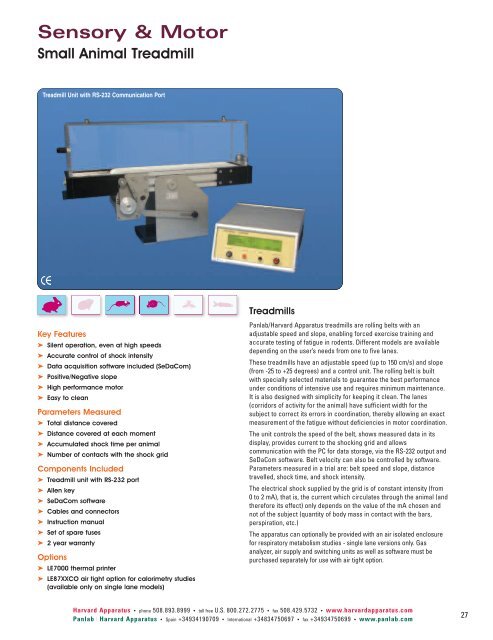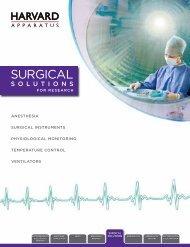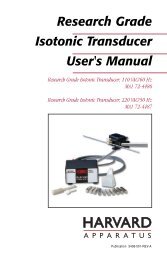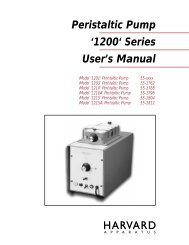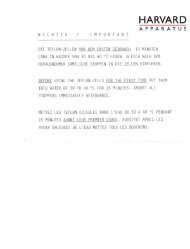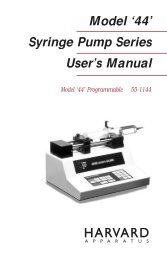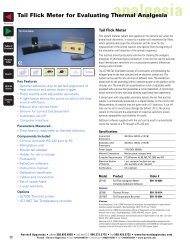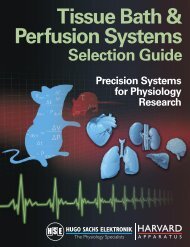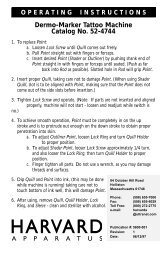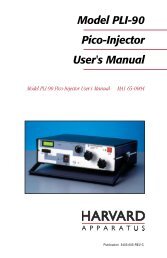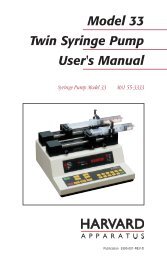View Catalog PDF - Harvard Apparatus
View Catalog PDF - Harvard Apparatus
View Catalog PDF - Harvard Apparatus
Create successful ePaper yourself
Turn your PDF publications into a flip-book with our unique Google optimized e-Paper software.
Sensory & Motor<br />
Small Animal Treadmill<br />
Treadmill Unit with RS-232 Communication Port<br />
Key Features<br />
➤ Silent operation, even at high speeds<br />
➤ Accurate control of shock intensity<br />
➤ Data acquisition software included (SeDaCom)<br />
➤ Positive/Negative slope<br />
➤ High performance motor<br />
➤ Easy to clean<br />
Parameters Measured<br />
➤ Total distance covered<br />
➤ Distance covered at each moment<br />
➤ Accumulated shock time per animal<br />
➤ Number of contacts with the shock grid<br />
Components Included<br />
➤ Treadmill unit with RS-232 port<br />
➤ Allen key<br />
➤ SeDaCom software<br />
➤ Cables and connectors<br />
➤ Instruction manual<br />
➤ Set of spare fuses<br />
➤ 2 year warranty<br />
Options<br />
➤ LE7000 thermal printer<br />
➤ LE87XXCO air tight option for calorimetry studies<br />
(available only on single lane models)<br />
Treadmills<br />
Panlab/<strong>Harvard</strong> <strong>Apparatus</strong> treadmills are rolling belts with an<br />
adjustable speed and slope, enabling forced exercise training and<br />
accurate testing of fatigue in rodents. Different models are available<br />
depending on the user’s needs from one to five lanes.<br />
These treadmills have an adjustable speed (up to 150 cm/s) and slope<br />
(from -25 to +25 degrees) and a control unit. The rolling belt is built<br />
with specially selected materials to guarantee the best performance<br />
under conditions of intensive use and requires minimum maintenance.<br />
It is also designed with simplicity for keeping it clean. The lanes<br />
(corridors of activity for the animal) have sufficient width for the<br />
subject to correct its errors in coordination, thereby allowing an exact<br />
measurement of the fatigue without deficiencies in motor coordination.<br />
The unit controls the speed of the belt, shows measured data in its<br />
display, provides current to the shocking grid and allows<br />
communication with the PC for data storage, via the RS-232 output and<br />
SeDaCom software. Belt velocity can also be controlled by software.<br />
Parameters measured in a trial are: belt speed and slope, distance<br />
travelled, shock time, and shock intensity.<br />
The electrical shock supplied by the grid is of constant intensity (from<br />
0 to 2 mA), that is, the current which circulates through the animal (and<br />
therefore its effect) only depends on the value of the mA chosen and<br />
not of the subject (quantity of body mass in contact with the bars,<br />
perspiration, etc.)<br />
The apparatus can optionally be provided with an air isolated enclosure<br />
for respiratory metabolism studies - single lane versions only. Gas<br />
analyzer, air supply and switching units as well as software must be<br />
purchased separately for use with air tight option.<br />
<strong>Harvard</strong> <strong>Apparatus</strong> • phone 508.893.8999 • toll free U.S. 800.272.2775 • fax 508.429.5732 • www.harvardapparatus.com<br />
Panlab | <strong>Harvard</strong> <strong>Apparatus</strong> • Spain +34934190709 • International +34834750697 • fax +34934750699 • www.panlab.com<br />
27


